air conditioning LINCOLN BLACKWOOD 2002 Owners Manual
[x] Cancel search | Manufacturer: LINCOLN, Model Year: 2002, Model line: BLACKWOOD, Model: LINCOLN BLACKWOOD 2002Pages: 248, PDF Size: 2.33 MB
Page 44 of 248
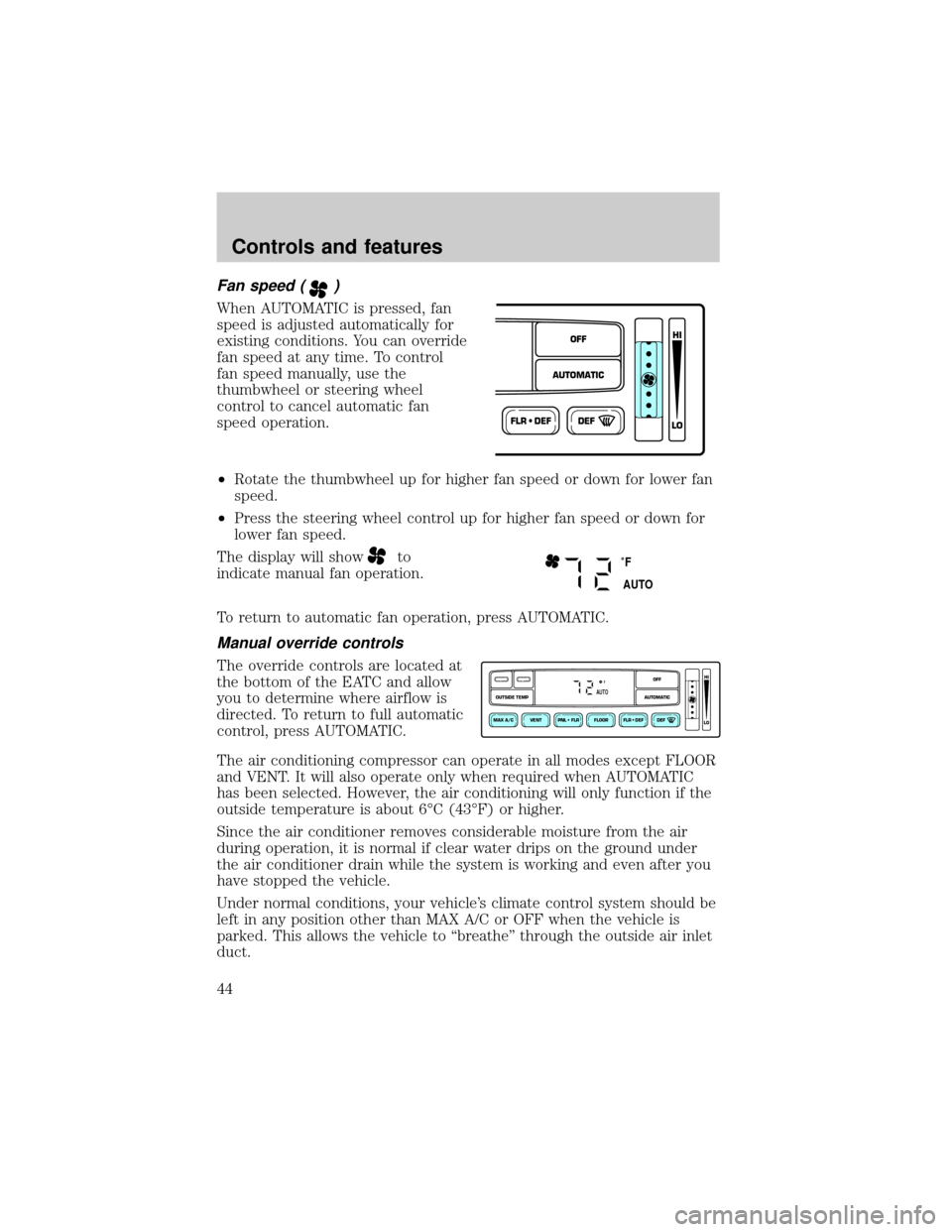
Fan speed ()
When AUTOMATIC is pressed, fan
speed is adjusted automatically for
existing conditions. You can override
fan speed at any time. To control
fan speed manually, use the
thumbwheel or steering wheel
control to cancel automatic fan
speed operation.
²Rotate the thumbwheel up for higher fan speed or down for lower fan
speed.
²Press the steering wheel control up for higher fan speed or down for
lower fan speed.
The display will show
to
indicate manual fan operation.
To return to automatic fan operation, press AUTOMATIC.
Manual override controls
The override controls are located at
the bottom of the EATC and allow
you to determine where airflow is
directed. To return to full automatic
control, press AUTOMATIC.
The air conditioning compressor can operate in all modes except FLOOR
and VENT. It will also operate only when required when AUTOMATIC
has been selected. However, the air conditioning will only function if the
outside temperature is about 6ÉC (43ÉF) or higher.
Since the air conditioner removes considerable moisture from the air
during operation, it is normal if clear water drips on the ground under
the air conditioner drain while the system is working and even after you
have stopped the vehicle.
Under normal conditions, your vehicle's climate control system should be
left in any position other than MAX A/C or OFF when the vehicle is
parked. This allows the vehicle to ªbreatheº through the outside air inlet
duct.
FLR • DEFDEF
HI
LO
AUTOMATICOFF
˚F
AUTO
VENT PNL • FLR FLOOR FLR • DEF DEF
HI
LO
MAX A/C
OUTSIDE TEMP AUTOMATICOFFFAUTO
Controls and features
44
Page 45 of 248
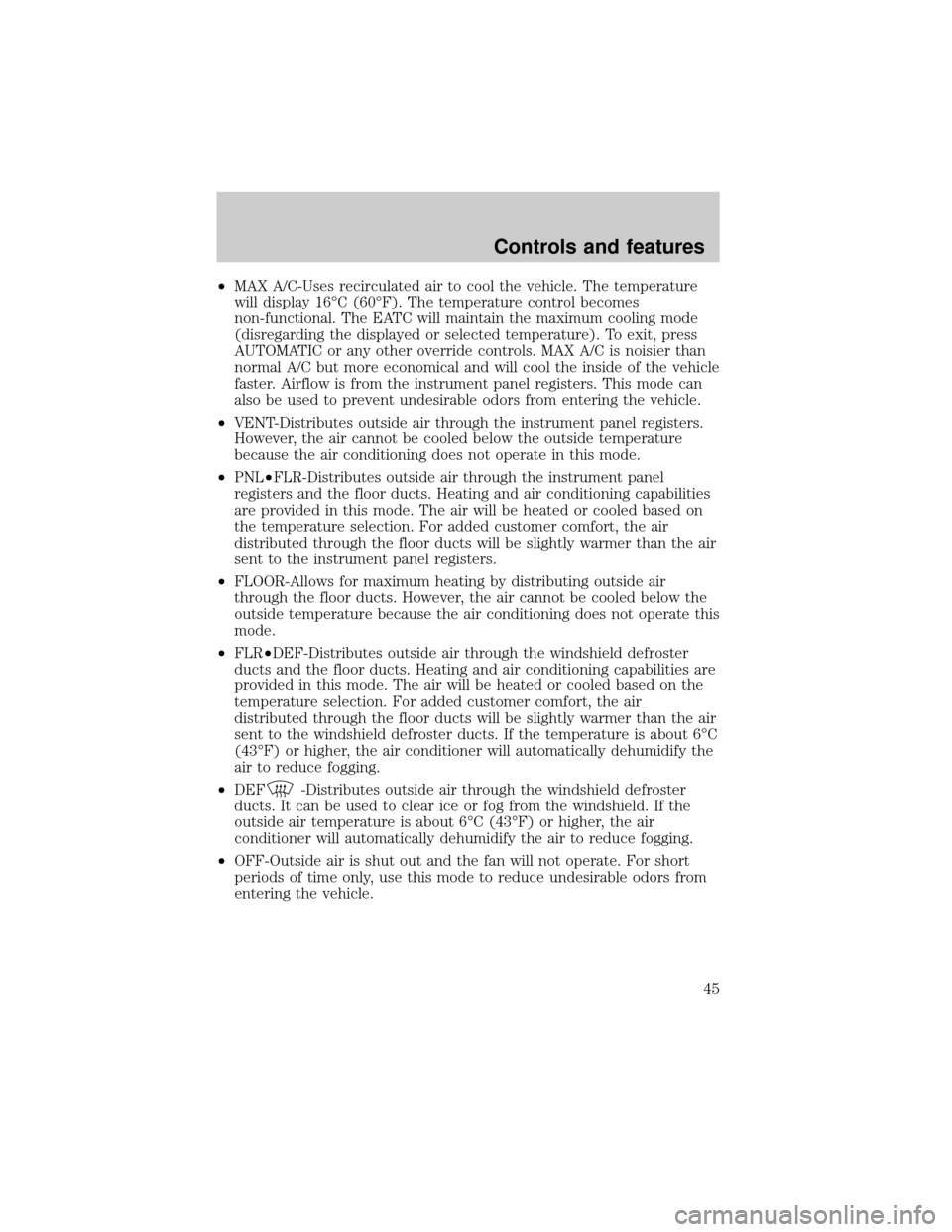
²MAX A/C-Uses recirculated air to cool the vehicle. The temperature
will display 16ÉC (60ÉF). The temperature control becomes
non-functional. The EATC will maintain the maximum cooling mode
(disregarding the displayed or selected temperature). To exit, press
AUTOMATIC or any other override controls. MAX A/C is noisier than
normal A/C but more economical and will cool the inside of the vehicle
faster. Airflow is from the instrument panel registers. This mode can
also be used to prevent undesirable odors from entering the vehicle.
²VENT-Distributes outside air through the instrument panel registers.
However, the air cannot be cooled below the outside temperature
because the air conditioning does not operate in this mode.
²PNL²FLR-Distributes outside air through the instrument panel
registers and the floor ducts. Heating and air conditioning capabilities
are provided in this mode. The air will be heated or cooled based on
the temperature selection. For added customer comfort, the air
distributed through the floor ducts will be slightly warmer than the air
sent to the instrument panel registers.
²FLOOR-Allows for maximum heating by distributing outside air
through the floor ducts. However, the air cannot be cooled below the
outside temperature because the air conditioning does not operate this
mode.
²FLR²DEF-Distributes outside air through the windshield defroster
ducts and the floor ducts. Heating and air conditioning capabilities are
provided in this mode. The air will be heated or cooled based on the
temperature selection. For added customer comfort, the air
distributed through the floor ducts will be slightly warmer than the air
sent to the windshield defroster ducts. If the temperature is about 6ÉC
(43ÉF) or higher, the air conditioner will automatically dehumidify the
air to reduce fogging.
²DEF
-Distributes outside air through the windshield defroster
ducts. It can be used to clear ice or fog from the windshield. If the
outside air temperature is about 6ÉC (43ÉF) or higher, the air
conditioner will automatically dehumidify the air to reduce fogging.
²OFF-Outside air is shut out and the fan will not operate. For short
periods of time only, use this mode to reduce undesirable odors from
entering the vehicle.
Controls and features
45
Page 61 of 248
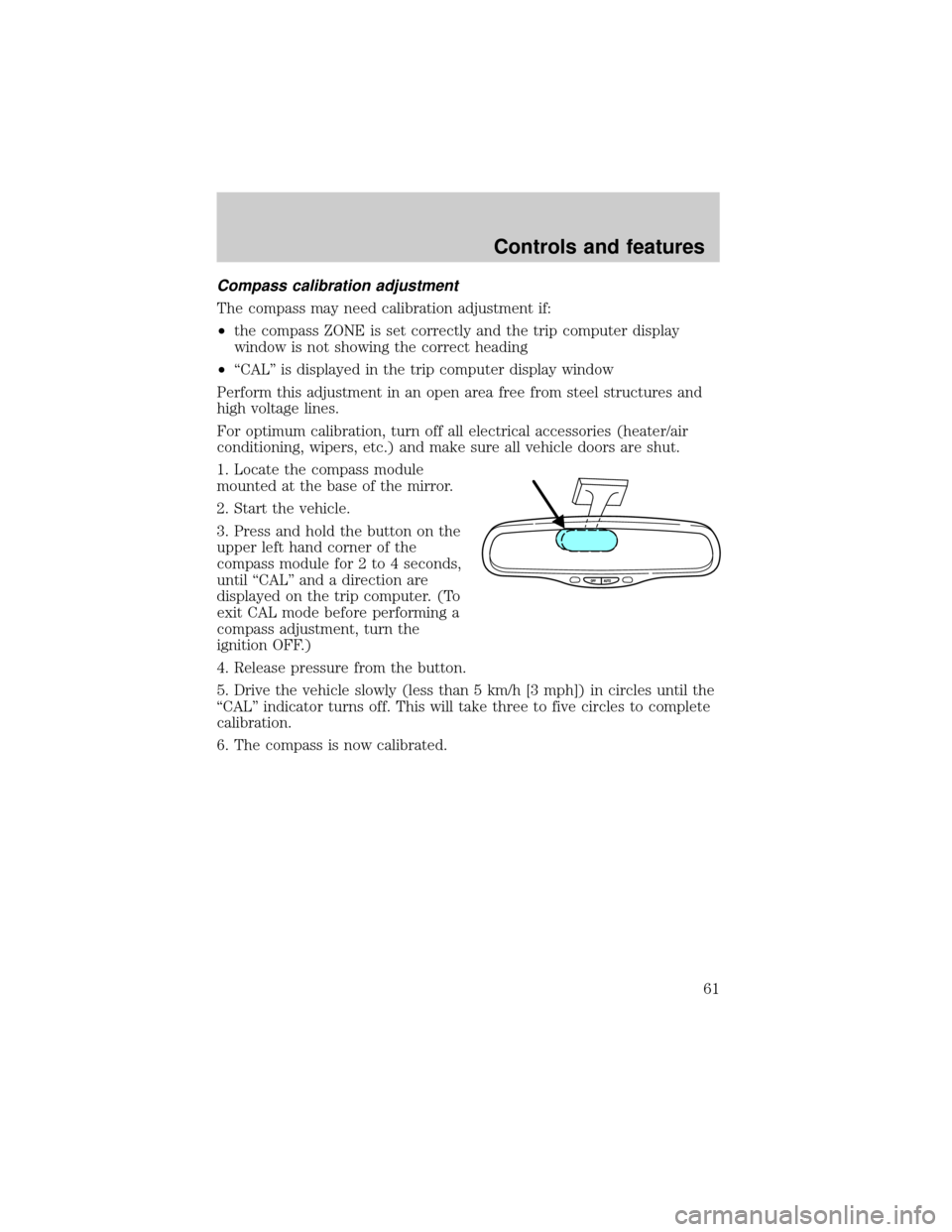
Compass calibration adjustment
The compass may need calibration adjustment if:
²the compass ZONE is set correctly and the trip computer display
window is not showing the correct heading
²ªCALº is displayed in the trip computer display window
Perform this adjustment in an open area free from steel structures and
high voltage lines.
For optimum calibration, turn off all electrical accessories (heater/air
conditioning, wipers, etc.) and make sure all vehicle doors are shut.
1. Locate the compass module
mounted at the base of the mirror.
2. Start the vehicle.
3. Press and hold the button on the
upper left hand corner of the
compass module for 2 to 4 seconds,
until ªCALº and a direction are
displayed on the trip computer. (To
exit CAL mode before performing a
compass adjustment, turn the
ignition OFF.)
4. Release pressure from the button.
5. Drive the vehicle slowly (less than 5 km/h [3 mph]) in circles until the
ªCALº indicator turns off. This will take three to five circles to complete
calibration.
6. The compass is now calibrated.
Controls and features
61
Page 128 of 248
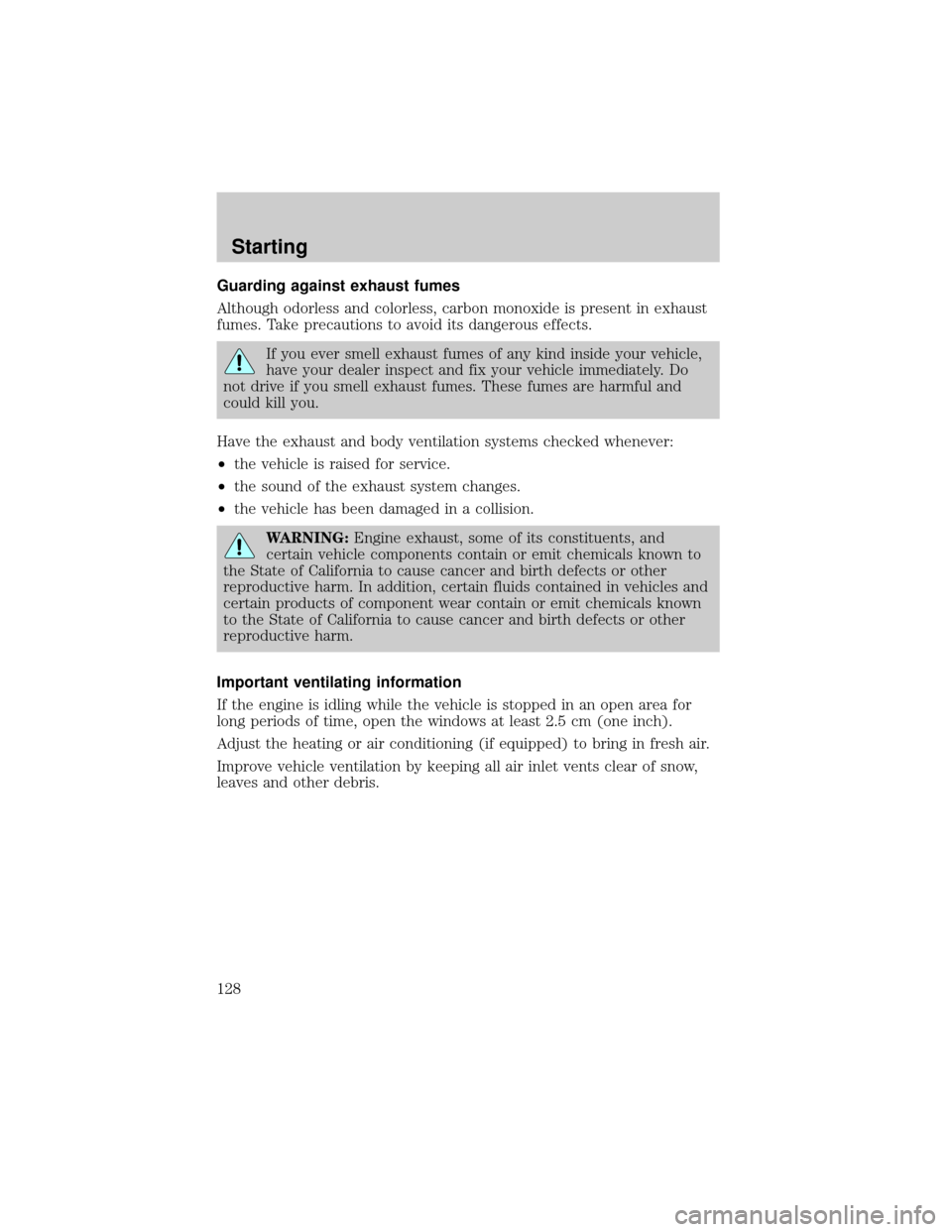
Guarding against exhaust fumes
Although odorless and colorless, carbon monoxide is present in exhaust
fumes. Take precautions to avoid its dangerous effects.
If you ever smell exhaust fumes of any kind inside your vehicle,
have your dealer inspect and fix your vehicle immediately. Do
not drive if you smell exhaust fumes. These fumes are harmful and
could kill you.
Have the exhaust and body ventilation systems checked whenever:
²the vehicle is raised for service.
²the sound of the exhaust system changes.
²the vehicle has been damaged in a collision.
WARNING:Engine exhaust, some of its constituents, and
certain vehicle components contain or emit chemicals known to
the State of California to cause cancer and birth defects or other
reproductive harm. In addition, certain fluids contained in vehicles and
certain products of component wear contain or emit chemicals known
to the State of California to cause cancer and birth defects or other
reproductive harm.
Important ventilating information
If the engine is idling while the vehicle is stopped in an open area for
long periods of time, open the windows at least 2.5 cm (one inch).
Adjust the heating or air conditioning (if equipped) to bring in fresh air.
Improve vehicle ventilation by keeping all air inlet vents clear of snow,
leaves and other debris.
Starting
128
Page 181 of 248
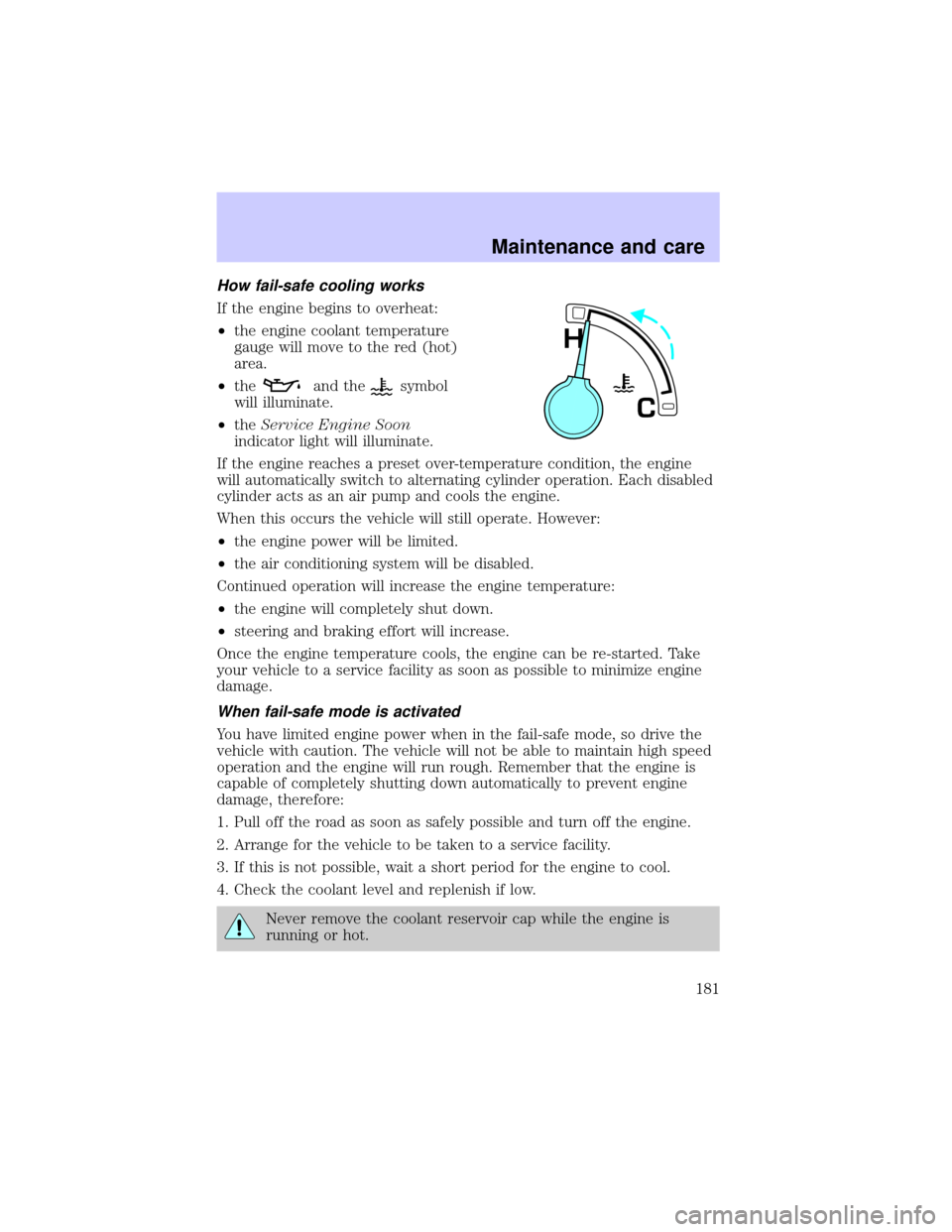
How fail-safe cooling works
If the engine begins to overheat:
²the engine coolant temperature
gauge will move to the red (hot)
area.
²the
and thesymbol
will illuminate.
²theService Engine Soon
indicator light will illuminate.
If the engine reaches a preset over-temperature condition, the engine
will automatically switch to alternating cylinder operation. Each disabled
cylinder acts as an air pump and cools the engine.
When this occurs the vehicle will still operate. However:
²the engine power will be limited.
²the air conditioning system will be disabled.
Continued operation will increase the engine temperature:
²the engine will completely shut down.
²steering and braking effort will increase.
Once the engine temperature cools, the engine can be re-started. Take
your vehicle to a service facility as soon as possible to minimize engine
damage.
When fail-safe mode is activated
You have limited engine power when in the fail-safe mode, so drive the
vehicle with caution. The vehicle will not be able to maintain high speed
operation and the engine will run rough. Remember that the engine is
capable of completely shutting down automatically to prevent engine
damage, therefore:
1. Pull off the road as soon as safely possible and turn off the engine.
2. Arrange for the vehicle to be taken to a service facility.
3. If this is not possible, wait a short period for the engine to cool.
4. Check the coolant level and replenish if low.
Never remove the coolant reservoir cap while the engine is
running or hot.
C
H
Maintenance and care
181
Page 238 of 248

A
Accessory delay ..........................70
Air bag supplemental restraint
system ................................111±112
and child safety seats ............114
description ..............................112
disposal ....................................116
driver air bag ..........................114
indicator light .....................9, 116
operation .................................114
passenger air bag ...................114
Air cleaner filter .......187±188, 218
Air conditioning ..........................41
rear seat controls .....................47
Air suspension ...........................132
description ..............................132
warning light .............................12
Ambulance packages ....................3
Antifreeze
(see Engine coolant) ................175
Anti-lock brake system
(see Brakes) ......................129±130
Anti-theft system
warning light .............................10
Audio system (see Radio) .........23
Automatic transmission
driving an automatic
overdrive .................................137
fluid, adding ............................183
fluid, checking ........................183
fluid, refill capacities ..............218
fluid, specification ..................222
Auxiliary power point .................19
Axle
lubricant
specifications ..................220, 222refill capacities ........................218
B
Battery .......................................185
acid, treating emergencies .....185
charging system
warning light .............................11
jumping a disabled battery ....162
maintenance-free ....................185
replacement, specifications ...218
servicing ..................................185
voltage gauge ............................15
Belt minder ...............................107
Brakes ........................................129
anti-lock ...........................129±130
anti-lock brake system
(ABS) warning light .........10, 129
brake warning light ..................10
fluid, checking and adding ....174
fluid, refill capacities ..............218
fluid, specifications .........220, 222
lubricant specifications ..220, 222
parking ....................................130
pedals (see Power adjustable
foot pedals) ...............................18
shift interlock ..........................135
Break-in period .............................3
C
Capacities for refilling fluids ....218
CD changer .................................37
Certification Label ....................224
Child safety restraints ..............117
child safety belts ....................117
Child safety seats ......................118
attaching with tether straps ..122
in front seat ............................119
Index
238
Page 239 of 248

in rear seat ..............................119
Cleaning your vehicle ...............212
exterior ....................................212
instrument cluster lens ..........216
instrument panel ....................216
interior .....................................216
plastic parts ....................214±215
safety belts ..............................217
washing ....................................212
waxing .....................................212
wheels ......................................213
windows ..................................216
wiper blades ............................215
woodtone trim ........................216
Climate control (see Air
conditioning or Heating) ............41
Clock ............................................21
Compass, electronic
calibration .................................61
set zone adjustment .................60
Console
overhead ....................................57
Controls
power seat .................................90
steering column ........................55
Coolant
checking and adding ..............175
refill capacities ................179, 218
specifications ..................220, 222
Cruise control
(see Speed control) ....................50
Customer Assistance ................147
Ford accessories for your
vehicle .....................................232
Ford Extended Service
Plan ..........................................225
Getting assistance outside
the U.S. and Canada ..............231Getting roadside assistance ...147
Getting the service
you need .................................225
Ordering additional owner's
literature .................................236
The Dispute Settlement
Board .......................................228
Utilizing the
Mediation/Arbitration
Program ...................................231
D
Defrost
rear window ..............................19
Dipstick
automatic transmission
fluid ..........................................183
engine oil .................................171
Doors
door ajar warning .....................11
lubricant specifications ..........220
Driveline universal joint and
slip yoke ....................................185
Driving under special
conditions
through water .........................146
E
Emergencies, roadside
jump-starting ..........................162
Emission control system ..........202
Engine ........................................222
check engine/service engine
soon light ....................................8
coolant .....................................175
fail-safe coolant ......................180
idle speed control ...................185
Index
239